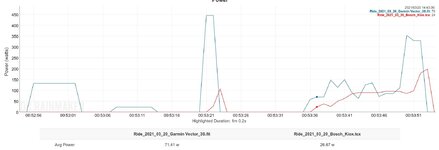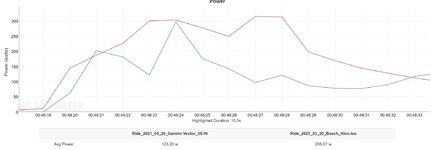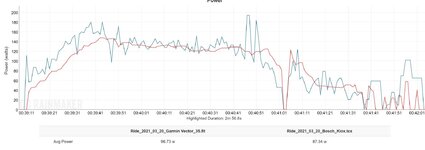Originally I had intended to sell my power meter pedals from my old ride, since the Bosch motor has one built in, but I am seeing a large difference in the data between the two. I'm reasonably sure the pedals are accurate and the Bosch numbers are not. There doesn't appear to be any way for the user to calibrate anything on the Bosch, which I understand as it's integral to the pedal assist. Has anyone else seen this?
You are using an out of date browser. It may not display this or other websites correctly.
You should upgrade or use an alternative browser.
You should upgrade or use an alternative browser.
2021 Domane+ HP, power meter accuracy?
- Thread starter ubt
- Start date
-
- Tags
- domane+ power meter
I was planning to make the same experiment and in my real world experience I am also very skeptical on the readings myself. Since pedal based power meters are built and tested for very high accuracies(%1-2), it is expected that the power meter functionality based on a mediocre sensor on a mid drive would not be as accurate but there were times that it didn't make sense.
Can you please tell us the difference in average readings on your pedals and bosch's own?
A year ago I even started a similar thread. You can find what I posted, my experiences here https://electricbikereview.com/forums/threads/nyon-power-measurement-accuracy.32603/.
The power meter functionality in Bosch is built on a not so good sensor hence I am not expecting high accuracy anyways. However in my experience it seemed quite off depending on how you rode.
I think it is a good way to track your fitness level compared to yourself in the past but that is pretty much it.
Can you please tell us the difference in average readings on your pedals and bosch's own?
A year ago I even started a similar thread. You can find what I posted, my experiences here https://electricbikereview.com/forums/threads/nyon-power-measurement-accuracy.32603/.
The power meter functionality in Bosch is built on a not so good sensor hence I am not expecting high accuracy anyways. However in my experience it seemed quite off depending on how you rode.
I think it is a good way to track your fitness level compared to yourself in the past but that is pretty much it.
Last edited:
I uploaded both sets of files to DC Rainmaker's analysis tool and there are indeed very large differences in the power data. The Kiox file is TCX format and the Garmin data was captured by a Hammerhead Karoo 2 in BLE mode as a FIT file. At first glance it looks like Bosch samples less frequently, but I'm not at all certain about that. Cadence data looks pretty good, though. There's some kind of issue with the speed data, maybe something to do with KPH vs MPH and a failed conversion somewhere. Public link is https://analyze.dcrainmaker.com/#/public/aecfba23-e458-4eda-606a-6a3fc59534fe, but I'm not certain how long that will work with a day pass.
Screen caps are attached, and I have also attached the cadence, speed, and power data in CSV format.
TLDR: @Johnny is right that the Kiox power data is useful only for a relative measure against yourself.






Screen caps are attached, and I have also attached the cadence, speed, and power data in CSV format.
TLDR: @Johnny is right that the Kiox power data is useful only for a relative measure against yourself.






Attachments
Last edited:
I uploaded both sets of files to DC Rainmaker's analysis tool and there are indeed very large differences in the power data. The Kiox file is TCX format and the Garmin data was captured by a Hammerhead Karoo 2 in BLE mode as a FIT file. At first glance it looks like Bosch samples less frequently, but I'm not at all certain about that. Cadence data looks pretty good, though. There's some kind of issue with the speed data, maybe something to do with KPH vs MPH and a failed conversion somewhere. Public link is https://analyze.dcrainmaker.com/#/public/aecfba23-e458-4eda-606a-6a3fc59534fe, but I'm not certain how long that will work with a day pass.
Screen caps are attached, and I have also attached the cadence, speed, and power data in CSV format.
TLDR: @Johnny is right that the Kiox power data is useful only for a relative measure against yourself.
View attachment 82229
View attachment 82230
View attachment 82231
View attachment 82232
View attachment 82234View attachment 82233
Thank you so much for this data. I didn't know if I would purchase my power meter before I sell my bike.
Unfortunately this confirms that the data is useful only for self assessment/relative measurements. At lower power outputs and when the output does not vary too much, it seems somewhat accurate, like %10 still not good but ok, anything else it is not.
This also explains my troubles. Varying between high and lows is completely off. For example 1:09 - 1:10 in your second graph, it completely missed some high outputs, averaged the rest etc.
Once again thank you very much for this comparison, I always wanted to see how usable the data was.
Last edited:
Thank you. Things felt off. This is a great analysis.I uploaded both sets of files to DC Rainmaker's analysis tool and there are indeed very large differences in the power data. The Kiox file is TCX format and the Garmin data was captured by a Hammerhead Karoo 2 in BLE mode as a FIT file. At first glance it looks like Bosch samples less frequently, but I'm not at all certain about that. Cadence data looks pretty good, though. There's some kind of issue with the speed data, maybe something to do with KPH vs MPH and a failed conversion somewhere. Public link is https://analyze.dcrainmaker.com/#/public/aecfba23-e458-4eda-606a-6a3fc59534fe, but I'm not certain how long that will work with a day pass.
Screen caps are attached, and I have also attached the cadence, speed, and power data in CSV format.
TLDR: @Johnny is right that the Kiox power data is useful only for a relative measure against yourself.
View attachment 82229
View attachment 82230
View attachment 82231
View attachment 82232
View attachment 82234View attachment 82233
It IS at times massive. The sudden highs are almost completely missed by a huge margin(even the rider's max is 484W vs 365 from kiox).The average power and weighted average power numbers actually don't seem that far off. I agree that there is a discrepancy, but it's not massive.



46 vs 30W, 71W vs 26W , 123W vs 205W, and these are from intervals ranging from 6 minutes to 15 seconds. All of these are long enough intervals, a good power meter should track in the range of %1-3 accuracy.
If one changes the effort level between high and low in short periods (like 5 second pushing hard then 5 seconds rest etc.) I expect this to lead to a huge difference overall(which I have experienced)!
On the other hand average power looks usable for everyday riders(still %10 difference) if the rider keeps its power stable for prolonged periods(no frequent starting/stopping etc.).

This is 96W vs 87W, around %10 which is fine.
As @ubt mentioned several things maybe the cause. The sampling rate maybe low. It is possible that the torque sensor output is too noisy so a short term averaging maybe applied. There also seems to be a delay when one starts and stops pedaling.
Also the likes of Strava can actually give estimations of similar accuracy without a power meter so that's that.
Comparing apples to oranges. So many variables to power meter readings especially if comparing an analog power meter to an electric assist power meter and what assist mode your in. Different assist modes react differently. You have to also consider bike weight differences and cadences as the assist is optimized with higher cadences. Really can't imagine how you could get any more accurate readings from a pedal mounted power meter on an electric assist bike than with the mid drive meter because of such variables. Can't see it that important as I'm sure we aren't going to be training for any e-bike races.
It is a perfect apples to apples comparison. These mid drives have clutches hence motor output can not have an effect on the strain on the pedals or crank arms. So the power measured by the pedal based power meter is rider input only and should be perfectly accurate. None of the things you have mentioned have any effect on that.
More importantly, these stand alone power meters are designed and calibrated to be 1-2 percent accurate and they pass through a certification process before leaving the factory. There are websites and youtubers who compare these power meters against each other and the good ones give very close and consistent data with each other. Accuracy is the reason why these power meters are so expensive.
In mid drives, accuracy is not a big deal as long as smoothness and responsiveness are achieved. The whole bosh mid drive costs around $800 while good single sided power meters are at least in the $300 400 range and the top of the line can exceed $1000. So the mediocre sensor in bosch is not supposed to match this accuracy, we just hoped that it was better unfortunately it is very inaccurate.
This functionality may not be crucial for many ebikers like yoruself, however for those who want power meter accuracy for training, this thread gives clear, hard evidence that the bosch's built in power meter is very inaccurate\unsuitable for that purpose.
More importantly, these stand alone power meters are designed and calibrated to be 1-2 percent accurate and they pass through a certification process before leaving the factory. There are websites and youtubers who compare these power meters against each other and the good ones give very close and consistent data with each other. Accuracy is the reason why these power meters are so expensive.
In mid drives, accuracy is not a big deal as long as smoothness and responsiveness are achieved. The whole bosh mid drive costs around $800 while good single sided power meters are at least in the $300 400 range and the top of the line can exceed $1000. So the mediocre sensor in bosch is not supposed to match this accuracy, we just hoped that it was better unfortunately it is very inaccurate.
This functionality may not be crucial for many ebikers like yoruself, however for those who want power meter accuracy for training, this thread gives clear, hard evidence that the bosch's built in power meter is very inaccurate\unsuitable for that purpose.
Comparing apples to oranges. So many variables to power meter readings especially if comparing an analog power meter to an electric assist power meter and what assist mode your in. Different assist modes react differently. You have to also consider bike weight differences and cadences as the assist is optimized with higher cadences. Really can't imagine how you could get any more accurate readings from a pedal mounted power meter on an electric assist bike than with the mid drive meter because of such variables. Can't see it that important as I'm sure we aren't going to be training for any e-bike races.
Last edited:
Similar threads
- Replies
- 74
- Views
- 23K
